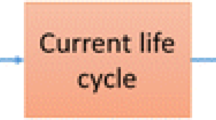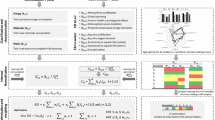Abstract
Purpose
As sustainability has become an important asset for production systems, it is important to conduct life cycle assessment (LCA) studies. When conducting an LCA of products derived from a multi-product process, the common challenge of impact partitioning arises. This is referred to as the allocation problem. Many allocation methods have been introduced in the literature, leading to a variety of results depending on the choice of allocation method. The purpose of this paper is to provide LCA practitioners with an operational approach that helps them choose the allocation method when evaluating co-products.
Methods
The extensive literature review carried out in the study allows identification of the main allocation methods available to practitioners. A cross-analysis also points out a strong link between allocation choices and decision-makers’ objectives. A decision-aid tool is introduced and tested on two case studies involving co-products.
Results and discussion
The resulting decision-aid tool helps guide the allocation choice in the two case studies through multi-level reasoning. Depending on the objective of the LCA study and the co-product being analyzed, a multi-level decision tree proposes a set of recommended allocation methods. The first level consists in identifying the purpose of the study, after which yes-or-no questions start to guide the path toward the right allocation method. In the most complex cases, the LCA practitioner is presented with a table containing all the allocation methods defended by other LCA practitioners for specific industries and contexts. This decision-aid tool complements the guidelines presented by ISO 14044 2006.
Conclusion
The presented tool creates a strong correlation between the aims of the study and the allocation choice, thus allowing practitioners to both justify their choice and to discuss the results with alternative scenarios for sensitivity analysis.




Similar content being viewed by others
References
Ayer NW, Tyedmers PH, Pelletier NL, Sonesson U, Scholz A (2007) Co-product allocation in life cycle assessments of seafood production systems: review of problems and strategies. Int J LCA 12(7):480
Azapagic A, Clift R (1999) Allocation of environmental burdens in co-product systems: product-related burdens (part 1). Int J LCA 4(6):357–369
Bartocci P, Fantozzi P, Fantozzi F (2017) Environmental impact of Sagrantino and Grechetto grapes cultivation for wine and vinegar production in central Italy. J Clean Prod 140:569–580
Beheshti Z, Chan YH, Nia HS, Hajihosseini F, Nazari R, Shaabani M (2012) Influence of apple cider vinegar on blood lipids. Life Sci J 9(4):2431–2440
Ben Rejeb H (2008) Phases amont de l'innovation: proposition d'une démarche d'analyse de besoin et d'évaluation de l'acceptabilité d'un produit. PhD Dissertation, University of Lorraine France
Binici H, Aksogan O, Shah T (2005) Investigation of fiber reinforced mud brick as a building material. Constr Build Mater 19(4):313–318
Brankatschk G, Finkbeiner M (2014) Application of the cereal unit in a new allocation procedure for agricultural life cycle assessments. J Clean Prod 73:72–79
Cherubini F, Bird ND, Cowie A, Jungmeier G, Schlamadinger B, Woess-Gallasch S (2009) Energy- and greenhouse gas-based LCA of biofuel and bioenergy systems: key issues, ranges and recommendations. Resour Conserv Recycl 52(8):434–447
Cherubini F, Strømman AH, Ulgiati S (2011) Influence of allocation methods on the environmental performance of biorefinery products: a case study. Resour Conserv Recycl 55(11):1070–1077
Christoforou E, Kylili A, Fokaides PA, Ioannou I (2006) Cradle to site life cycle assessment of adobe bricks. J Clean Prod 112:443–452
Dalgaard R, Schmidt J, Halberg N, Christensen P, Thrane M, Pengue WA (2008) LCA of soybean meal. Int J LCA 13(3):240
De Oliveira MC, Sichieri R, Venturim Mozzer R (2008) A low-energy-dense diet adding fruit reduces weight and energy intake in women. Appetite 51(2):291–295
EPD (Environmental Product Declaration) (2021) Construction products. Technical Report, EDP
Ekvall T, Tillman AM (1997) Open-loop recycling: criteria for allocation procedures. Int J LCA 2(3):155
Esteban B, Baquero G, Puig R, Riba JR, Rius A (2011) Is it environmentally advantageous to use vegetable oil directly as biofuel instead of converting it to biodiesel? Biomass Bioenergy 35(3):1317–1328
Flysjö A, Cederberg C, Henriksson M, Ledgard S (2011) How does co-product handling affect the carbon footprint of milk? case study of milk production in New Zeeland and Sweden. Int J LCA 16(5):420–430
Frischknecht R (2000) Allocation in life cycle inventory analysis for joint production. Int J LCA 5(2):85–95
Gnansounou E (2018) Coproducts performances in biorefineries: development of claiming-based allocation models for environmental policy. Bioresour Technol 254:31–39
Gnansounou E, Raman JK (2018) Environmental performances of coproducts. Application of claiming-based allocation models to straw and vetiver biorefineries in an Indian context. Bioresour Technol 262:203–211
Heijungs R, Guinée JB (2007) Allocation and ‘what-if’ scenarios in life cycle assessment of waste management systems. Waste Manag 27(8):997–1005
Horta Arduin R, Grimaud G, Martínez Leal J, Pompidou S, Charbuillet C, Laratte B, Alix T et al (2019) Influence of scope definition in recycling rate calculation for European e-waste extended producer responsibility. Waste Manag 84:256–268
Huppes G (1992) Allocating impacts of multiple economic processes in LCA. SETAC-Europe Life-cycle assessment. SETAC-Europe, Brussels, pp 57–70
ISO 14041 (1998) Environmental management: life cycle assessment; Goal and scope definition and inventory analysis. 1998. ISO
ISO 14044 (2006) Environmental management: life cycle assessment; Principles and framework. 2006. ISO
Jolliet O, Saadé-Sbeih M, Crettaz P, Jolliet-Gavih N, Shaked S (2017) Analyse du cycle de vie : comprendre et réaliser un écobilan. Presses Polytechniques Romandes, Lausanne
Jungmeier G, Werner F, Jarnehammar A, Hohenthal C, Richter K (2002) Allocation in LCA of wood-based products experiences of cost action E9. Int J LCA 7(6):369–375
Kodera K (2007) Analysis of allocation methods of bioethanol LCA. Dissertation, Faculty of Earth and Life Science of Amsterdam
Koltun P, Tharumarajah A, Ramakrishnan S (2005) An approach to treatment of recycling in LCA study, The fourth Australian LCA Conference, 23–25 February 2005. CSIRO Division of Manufacturing and Infrastructure Technology, Sydney, Australia
Li X, Mupondwa E, Panigrahi S, Tabil L, Adapa P (2012) Life cycle assessment of densified wheat straw pellets in the Canadian prairies. Int J LCA 17(4):420–431
Mackenzie SG, Leinonen I, Kyriazakis I (2017) The need for co-product allocation in the life cycle assessment of agricultural systems—is “biophysical” allocation progress? Int J LCA 22(2):128–137
Nguyen TLT, Hermansen JE (2010) System expansion for handling co-products in LCA of sugar cane bioenergy systems: GHG consequences of using molasses for ethanol production. Appl Energy 89(1):254–261
Parsons S, Allen MJ, Chuck CJ (2020) Coproducts of algae and yeast-derived single cell oils: a critical review of their role in improving biorefinery sustainability. Bioresour Technol 303:122862
Paulillo A, Striolo A, Lettieri P (2019) The environmental impacts and the carbon intensity of geothermal energy: a case study on the Hellisheiði plant. Environ Int 133: 105226
Ren KB, Kagi DA (1995) Upgrading the durability of mud bricks by impregnation. Build Environ 30(3):433–440
Sandin G, Røyne F, Berlin J, Peters GM, Svanström M (2015) Allocation in LCAs of biorefinery products: implications for results and decision-making. J Clean Prod 93:213–221
Saskatchewan Agriculture and Food (2005) Food principles and practices of crop rotation. Technical Report, Food Government of Saskatchewan
Serena A, Knudsen KB (2007) Chemical and physicochemical characterisation of co-products from the vegetable food and agro industries. Anim Feed Sci Technol 139:109–124
Schau EM, Fet AM (2007) LCA studies of food products as background for environmental product declarations. Int J LCA 13(3):255–264
Schrijvers DL, Loubet P, Sonnemann G (2016a) Developing a systematic framework for consistent allocation in LCA. Int J LCA 21:976–993
Schrijvers DL, Loubet P, Sonnemann G (2016b) Critical review of guidelines against a systematic framework with regard to consistency on allocation procedures for recycling in LCA. Int J LCA 21:994–1008
Schrijvers DL, Loubet P, Sonnemann G (2020) Archetypes of goal and scope definitions for consistent allocation in LCA. Sustainability 12(14):5587
Stamp A, Althaus HJ, Wäger PA (2013) Limitations of applying life cycle assessment to complex co-product systems: the case of an integrated precious metals smelter-refinery. Resour Conserv Recycl 80:85–96
Svanes E, Vold M, Hanssen OJ (2011) Effect of different allocation methods on LCA results of products from wild-caught fish and on the use of such results. Int J LCA 16(6):512–521
Thomassen MA, Dalgaard R, Heijungs R, De Boer I (2008) Attributional and consequential LCA of milk production. Int J LCA 13(4):339–349
Wang M, Lee H, Molburg J (2004) Allocation of energy use in petroleum refineries to petroleum products: implications for life-cycle energy use and emission inventory of petroleum transportation fuels. Int J LCA 9(1):34–44
Wardenaar T, Ruijven T, Beltran AM, Vad K, Guinée J, Heijungs R (2012) Differences between LCA for analysis and LCA for policy: a case study on the consequences of allocation choices in bio-energy policies. Int J LCA 17(8):1059–1067
Weidema B (1993) Market aspects in product life cycle inventory methodology. J Clean Prod 1(3):161–166
Weidema B (2000) Avoiding co-product allocation in life-cycle assessment. J Ind Ecol 4(3):11–33
Weidema B (2003) Market information in life cycle assessment. Technical Report, Miljøstyrelsen
Winther U, Ziegler F, Hognes ES, Emanuelsson A, Sund V, Ellingsen H (2009) Carbon footprint and energy use of Norwegian seafood products. Technical Report, SINTEF Fisheries and Aquaculture
Wolf MA, Chomkhamsri K, Brandao M, Pant R, Ardente F, Pennington DW, Goralczyk M (2010) ILCD handbook-general guide on LCA-detailed guidance. Technical Report, Joint Research Centre European Commission
Author information
Authors and Affiliations
Corresponding author
Additional information
Communicated by Serenella Sala.
Publisher's Note
Springer Nature remains neutral with regard to jurisdictional claims in published maps and institutional affiliations.
Rights and permissions
About this article
Cite this article
Ijassi, W., Ben Rejeb, H. & Zwolinski, P. Environmental impact evaluation of co-products: decision-aid tool for allocation in LCA. Int J Life Cycle Assess 26, 2199–2214 (2021). https://doi.org/10.1007/s11367-021-01984-0
Received:
Accepted:
Published:
Issue Date:
DOI: https://doi.org/10.1007/s11367-021-01984-0




